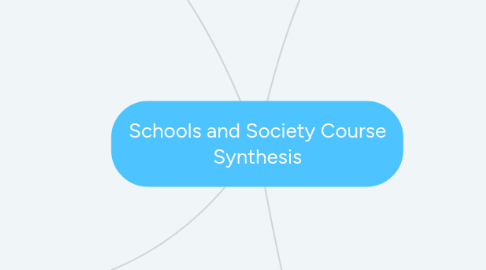
1. Educational Equality and Diversity
1.1. equality of educational opportunity: everyone gets the same chance to receive the same quality education
1.1.1. Race and segregation being a legal way of declining diverse student populations (anyone who does not fit the legal definition of Eastern European/Anglo Saxon white) equal education
1.1.1.1. New segregation through economic proxy- discrimination against Latino students
1.1.2. Title IX and debates on protection from sex based discrimination
1.1.2.1. Includes protection for students who are or are perceived as LGBTQ+
1.1.3. institutionalization to inclusion of students with disabilities
1.2. Empowerment through Multicultural and multinational education
1.2.1. How does diversity impact how students view the world and learn?
2. Influences on the system of education
2.1. National
2.1.1. categorical federal aid used to push stipulations on curriculum and standards, rise in national regulation and funding of public schools
2.1.1.1. No Child Left Behind and Race to the Top
2.1.1.1.1. High Stakes Testing and Performance based evaluations
2.1.1.2. Common Core
2.2. Local
2.2.1. schools boards- local community control through representatives (not representative of the community in most cases, highly white, male, well-educated subsections)
2.2.2. school choice
2.2.2.1. public school choice-moving from dangerous or underpeforming schools
2.2.2.2. private schools
2.2.2.2.1. Mueller vs Allen allows for vouchers that support religious private schools as long as the vouchers have a secular purpose and does not involve the government heavily with religion
2.2.2.3. charter schools- receive public funding but have flexibility in approach or subject matter, students chosen by lottery
2.2.2.4. home school
2.3. State
2.3.1. regulates public, private, charter, and home schools
2.3.2. licenses teachers, sets curriculum and standards
2.4. Global
2.4.1. dominance of human capital and consumerism
2.4.2. skills over knowledge in creating competitive graduates
2.4.3. The Global Education Business
2.4.3.1. Shadow Education
2.4.3.2. Online Schools and Educational Resources
3. Purposes of Schooling
3.1. Political
3.1.1. includes things like like learning about how to be a citizen, understanding the workings of the US government, and creating shared political goals/foundation
3.1.2. Should schools teach patriotism? Is school part of socializing children to nationalist values?
3.1.3. Censorship related to political (and typically pseudochristian values?
3.1.3.1. Don McLeroy and the Texas School board fiasco over teaching evolution
3.1.3.1.1. Texas and other large states politically argue over subjects in textbooks that are sold nationwide
3.1.3.2. Tinker vs Des Moines discusses students' rights regarding free speech
3.1.4. Is it working? The stats do not show increased voter turnout
3.2. Social
3.2.1. Includes items such as moral instruction, sex ed, school provided healthcare, nutrition through school lunches, and community building activities
3.2.2. Debates over whether moral values should be secular (focusing on kindness and sharing) or aligned with Christian values
3.2.2.1. Connections to certain religions not being LGBTQ+ friendly/positive which impacts sex ed
3.2.2.1.1. No Child Left Behind does not allow monetary support for programs not focused on abstinence
3.2.3. Does moral education reduce crime?
3.2.3.1. Yes and no- original thoughts did not account for school violence, no shown decline
3.3. Economic
3.3.1. human capital theory: education is an investment in future productivity, human ingenuity is a form of capital
3.3.1.1. life-long learning
3.3.1.2. Perry preschool study and the efficacy of investing in students early on
3.3.1.3. social capital and breeding of similar social classes through limited opportunities
3.4. Historical
3.4.1. George Washington and national university for political leaders
3.4.2. Thomas Jefferson and free elementary education for critical reading with merit based scholarships
3.4.3. Horace Mann and school as the foundation of common values
3.4.4. Protected (recess, kids should get to act like kids) or prepared (sacrifice in personal enjoyment for career and college readiness) childhood
3.5. Equality of Opportunity
3.5.1. everyone is given a fair and equal chance to pursue prosperity
3.5.2. Continued inequalities based on race, gender, and social class on educational and career outcomes
3.5.3. Using different models of schooling to address it
3.5.3.1. Common school- everyone gets the same education, sorting happens after graduation
3.5.3.2. Sorting Machine model- students sorted through metrics and observation into academic routes that give specialized education based on ability
3.5.3.2.1. high stakes testing model
4. What is an American teacher?
4.1. Role of Teachers
4.1.1. How has the role of a teacher evolved over time?
4.1.1.1. High qualified, deskilled teachers under Race to the Top
4.1.1.2. Social welfare worker and vocational trainer during industrialization
4.1.1.3. civil war and feminizing of teaching profession
4.1.1.4. certification and professionalization in 1930s
4.1.1.5. 1950s and the Red Scare- defenders of American values
4.1.2. NEA and AFT teaching unions
4.1.3. Teacher's Rights and Liability
4.1.3.1. Should teachers go on strike?
4.1.3.2. Do teachers' private lives impact teaching? Grounds for dismissal?
4.1.3.3. Teachers are obligated to keep students safe and can be evaluated for negligence under basic liability.
